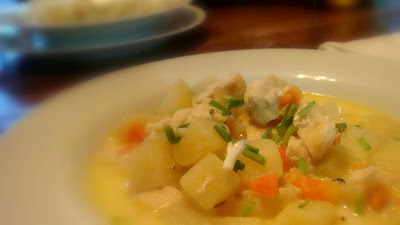Real "Down-East" Fish Chowder
My Grandfather used to tell me that the first word I spoke as a toddler was "sish" and that I loved my Grandmothers "sish" chowder more than any other food in my maritime diet. As a matter of fact, for my entire childhood, the menu at my August birthday parties, which were usually held on various small deserted islands in the Bay of Fundy, was fish chowder with hot biscuits and buns, and deep dish raspberry/blueberry combo pies, lovingly prepared by my mother and carried in large pots down iron wharf ladders to the boat to be ferried, along with all the kids from the island village, to the site my father had chosen for the year's festivities. But I digress.
When I saw that Drew of "How to Cook Like Your Grandmother" was asking for ideas for things to cook, the first thing that came to mind was good ol' down east fish chowder, served with fluffy hot buttermilk biscuits, just like MY grandmother used to make, and my mother still does make, whenever she gets the chance to spoil me! Drew volunteered to make the biscuits, if I would do the chowder, and thus was born the first co-blogging event in which I have participated.
I realized right away that this was going to be an interesting challenge to make real fish chowder here in the middle of the jungle. And I have to admit that if it hadn't been for the new Walmart (yes, we now have a Walmart ... they actually arrived before MacDonalds and Starbucks!), I would have had some real problems finding a white fish that would give the flavor that I was looking for.
Many of the fish chowders of my youth were as a direct result of fishing trips, where we would 'throw back' everything but the "haddock" ... the king of chowder fish (also the king of baked haddock and fish 'n chips, but that is for another blog). Haddock is a firm white-fleshed fish with a mild flavor ... it should never be even slightly fishy smelling. It has a mark on the side up by the fin that we were always told was the "Devil's thumbprint", left when he made a grab for a haddock and the haddock slipped away. Much to my sorrow, they are pretty well fished-out these days and what is available is very expensive. And, as you can imagine, there is no haddock to be found at all around this neck of the woods.
I was relieved, therefore, when I found, in the Walmart grocery section, "filet de troncho". This is a true mystery fish for me ... I have never heard of it before. I googled it, and it didn't turn up there. Eventually I found some reference to "troncho" as meaning something like "a type of a cut of meat or fish" like a "troncho of sirlion" for example. In which case, it doesn't really make sense, since "filet" also means "a type of a cut of meat or fish" like a "filet of sirloin". Its a true mystery. However, the good part is that it was a very haddock-y looking white fish, no small bones (which is a prime consideration when making chowder), so I figured I was ready to go.
Real "Down-East" Fish Chowder
Ingredients:
2 large filets of haddock (or another similar fish with no small bones)
4 potatoes
1 onion
1/3 of a carrot, chopped
1 cup of evaporated milk or heavy cream or 1/2 milk and 1/2 cream
butter
salt and pepper

Instructions:
1. Melt about 1 Tbsp of butter in heavy bottomed pan.
2. Chop onion; add to melted butter and saute

3. Add chopped carrot and stir in; saute another minute.

4. Peel potatoes and cut in cubes.
5. Add potatoes to onion/carrot mixture and stir to combine.

6. Add 1 cup water.
7. Salt and pepper.

8. Cover; bring to a slow boil and immediately turn down to simmer.
9. Simmer for 10 minutes.

10. Add the two fish filets

11. Cover and simmer another 10 minutes, until filets are white and just cooked.

12. Using 2 forks, gently flake fish into small pieces and stir through the chowder.

13. Add 1 Tbsp of butter

14. And the evaporated milk or cream.

15. Stir and heat gently. Correct Seasoning.

16. Ladle into bowls; top with freshly snipped chives and another pat of butter and serve with hot fluffy buttermilk biscuits, which are baking at "How to Cook Like Your Grandmother"

Verdict:
Comfort foods just don't come much more comfortable than this! "Sish" Chowder like my grandmother and mother used to make is still one of my favorite foods!! The filet de troncho was a perfect substitution for the haddock. This chowder is so fast and easy with so few ingredients, that one would never guess at the superb flavor. Yes, I will make it again here in the jungle.
I don't think anyone will disagree that the perfect accompaniment to a Real Down-East Fish Chowder is ... Ta da ... Fresh, Hot, Flaky Buttermilk Biscuits, which should be coming out of the oven now at "How to Cook Like Your Grandmother".
Oops ... a slight change in the menu ... we are now serving the chowder with Fresh, Hot Sourdough Biscuits ... check them out!

























